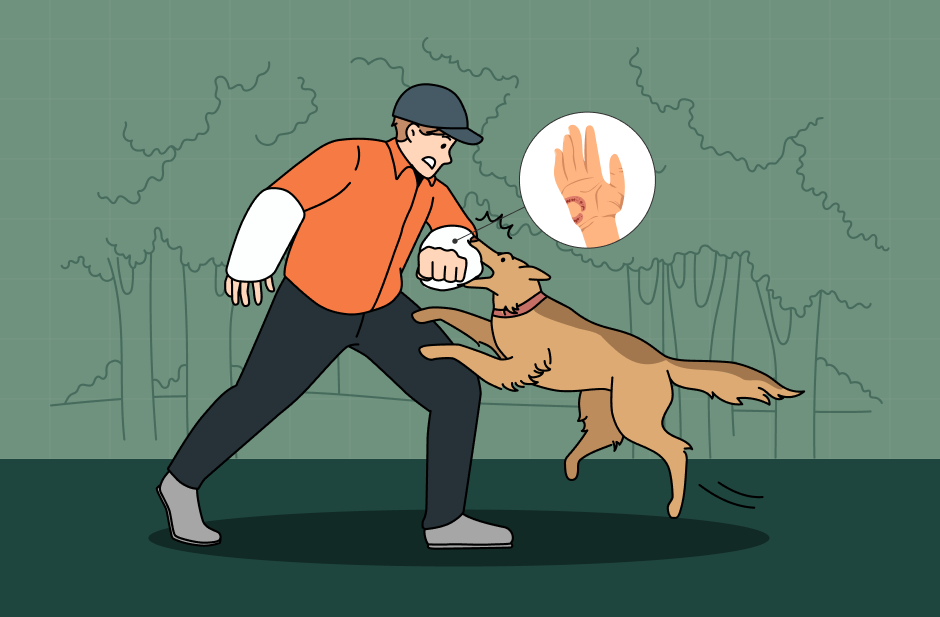Did you know that dog bite claims aren’t evaluated solely on whether a bite occurred? Rather, the severity of the injury—the dog bite level—can shape nearly every part of the case.
Yes, you read that right!
The level of dog bite and the severity of the injury that it has caused greatly affect the following things:
- Insurance company’s assessment of liability.
- Calculation of damages.
- Any consequences that the owner of the dog might face.
To understand how bite level influences personal injury cases, it helps to look at how bite behavior is categorized, what attorneys and insurers examine, and how courts and dog bite laws factor in severity during negotiations or trials.
The Dunbar Bite Scale
Veterinarian and behaviorist Dr. Ian Dunbar developed a 6-level bite scale that categorizes bites by severity.
Although it wasn’t created for legal use, this scale is frequently cited in bite investigations and court proceedings to describe what happened and evaluate risk.
Dunbar Scale Overview
| Level | Description | Legal Relevance |
| 1 | No skin contact. Threat display only. | May support a defense that the dog was only posturing. Often no case. |
| 2 | Skin contact without puncture. May bruise or scratch. | Evidence of aggression but no lasting injury. Could limit damages. |
| 3 | One to four punctures, each less than half the length of the dog’s canine teeth. May include tearing. | Serious enough to support medical claims, pain and suffering, and long-term monitoring. |
| 4 | One to four punctures plus deep bruising or tearing from shaking. | Indicates dangerous behavior and justifies higher damage calculations. May affect homeowner’s coverage. |
| 5 | Multiple bites or a sustained attack. | Strong evidence of risk and negligence. Typically results in higher compensation or penalties. |
| 6 | Victim dies from the attack. | Criminal charges possible. Civil lawsuits may include wrongful death. |
The higher the bite level, the more complex the legal picture becomes.
What Injury Attorneys Look For First
When a dog injures someone, the dog bite level chart is just the starting point. Personal injury lawyers examine the entire situation, but they begin by asking:
- What is the medical diagnosis and treatment plan?
- Were stitches, surgery, or rabies shots required?
- Is the injury in a sensitive or visible location?
- Did the bite affect the victim’s ability to work or function?
- What’s the long-term prognosis?
Medical records that document wound size, infection risk, nerve damage, and disfigurement all help establish the severity of the bite and sometimes more persuasively than photos alone.
Level 3–5 Bites: Where Most Lawsuits Begin
Dog bite Level 1 and 2 bites rarely justify a personal injury claim. They may involve minor scratches or bruises but don’t usually result in medical bills or lost wages.
Claims that move forward tend to involve at least a Dog bite Level 3 injury, which are the cases where victims:
- Seek emergency care
- Miss work or school
- Receive antibiotics or pain management
- Face scarring, disfigurement, or mobility loss
Medical testimony, trauma counseling, and long-term care plans become more common in Dog bite Level 4 and 5 cases. Each added layer raises the claim’s value and draws closer attention from insurers.
Owner Liability And Bite History
Severity also interacts with what’s known about the dog beforehand. Did the owner know the dog was dangerous? Has it been bitten before?
Higher bite levels with no documented warnings may be treated differently than a Level 2 bite after multiple reports to animal control.
Key Liability Indicators
- Prior complaints to animal control
- Warning signs posted (or lack thereof)
- Muzzle use or restraint history
- Leash compliance at the time of the bite
- Whether the victim was invited onto the property
If the owner ignored safety measures or concealed a history of aggression, higher bite levels may tip the case into gross negligence territory.
Bite Location And Long-Term Impact
Where the bite occurred on the body matters—not just for medical reasons, but for how damages are calculated.
Bites That Raise Red Flags
- Face or neck – Higher chance of scarring or nerve damage. May trigger psychological claims.
- Hands or fingers – Can impact fine motor skills or prevent someone from returning to work.
- Legs or knees – May reduce mobility or require surgery.
A Level 3 bite to the hand that requires surgery may lead to higher compensation than a Level 4 on the thigh that heals quickly. Functional impact carries more weight than bite level alone.
Settlement Value Tied To Bite Level
Insurers use bite level to help assess case value. In cases involving scarring, reconstructive surgery, or long-term psychological effects, bite level helps establish:
- General damages (pain, suffering, trauma)
- Economic damages (medical bills, lost income)
- Future care costs (physical therapy, counseling)
- Punitive damages (in rare cases with gross negligence)
Higher bite levels also bring stronger pressure to settle, as the risk of a large jury verdict increases. That’s especially true if the dog had a known history or the attack occurred in public.
What To Document If You’re Bitten
If you or a family member suffers a serious dog bite, preserve as much evidence as possible—especially before the wound begins to heal.
Recommended Documentation
- Medical records (ER visit, diagnosis, follow-up)
- Photos of injuries at every stage of healing
- Statements from witnesses (neighbors, passersby)
- Animal control reports or prior complaints
- Insurance or property information from the dog’s owner
Even if you’re unsure whether a case will move forward, having this documentation can be the difference between a dismissed claim and a fully covered one.
Behavior Assessments And Bite Level Disputes
Not all bite levels are accepted without question. Attorneys may bring in dog behavior experts to provide context. For example:
- Did the dog bite defensively, or did it pursue the victim?
- Was the bite an isolated reaction, or part of a sustained attack?
- Was the dog provoked or startled?
In close cases, particularly Level 3 bites with disputed facts, expert input can sway outcomes by reframing how the bite is interpreted.
What Compensation Could I Receive From A Dog Bite Claim?
If you have suffered a dog bite injury, then you are entitled to many different types of compensation to cover the cost of those injuries. These costs usually cover the following expenses.
- Medical bills for the treatment and rehabilitation period.
- The long-term care for the prolonged and permanent disability resulting from the dog bite.
- Lost income or wages due to loss of work, resulting from dog bite.
- Loss of earning capacity in the future, due to severe injury from the bite.
- Suffering and pain from trauma and physical discomfort.
- Any emotional distress that includes stress, anxiety or if you have developed a fear of dogs after the attack.
- Damage to personal property might include glasses, clothing, and shoes.
Your Legal Guide: How Attorneys Evaluate Bite Injury Cases
According to Lesser, Landy, Smith & Siegel, PLLC, dog bite cases hinge on details that many owners and victims overlook now. In their review of dog bite lawsuits, they focus on:
- Bite level and documented severity
- Known history of the dog’s behavior
- Compliance with leash laws or safety ordinances
- Quality and consistency of medical documentation
Their experience reinforces what most dog bite attorneys will tell you: severity shapes outcomes.
When documented clearly, Level 3 and above give victims a better chance at fair compensation and meaningful resolution.
The dog bite level doesn’t just determine how bad the injury is—it influences whether a claim is viable, how much compensation may be available, and how fault is assigned.
If you’re dealing with a serious bite or a child was injured, ask for a copy of the medical records and report the bite to the appropriate authorities.
From there, talk to a personal injury lawyer with experience in dog bite litigation. Bite level isn’t everything, but in close cases, it can change everything.
Read Also:
















